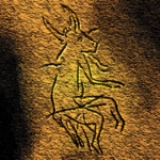
Neolithic religion
Overview
Religion
Religion is a collection of cultural systems, belief systems, and worldviews that establishes symbols that relate humanity to spirituality and, sometimes, to moral values. Many religions have narratives, symbols, traditions and sacred histories that are intended to give meaning to life or to...
of prehistoric
Prehistory
Prehistory is the span of time before recorded history. Prehistory can refer to the period of human existence before the availability of those written records with which recorded history begins. More broadly, it refers to all the time preceding human existence and the invention of writing...
peoples. More specifically it encompasses Paleolithic religion
Paleolithic religion
Religious behaviour is thought to have emerged by the Upper Paleolithic, before 30,000 years ago at the latest,but behavioral patterns such as burial rites that one might characterize as religious - or as ancestral to religious behaviour - reach back into the Middle Paleolithic, as early as 300,000...
, Mesolithic
Mesolithic
The Mesolithic is an archaeological concept used to refer to certain groups of archaeological cultures defined as falling between the Paleolithic and the Neolithic....
religion, Neolithic religion
Neolithic religion
Prehistoric religion is a general term for the religious beliefs and practices of prehistoric peoples. More specifically it encompasses Paleolithic religion, Mesolithic religion, Neolithic religion and Bronze Age religion.-Burial:...
and Bronze Age religion.
Intentional burial
Burial
Burial is the act of placing a person or object into the ground. This is accomplished by excavating a pit or trench, placing an object in it, and covering it over.-History:...
, particularly with grave goods
Grave goods
Grave goods, in archaeology and anthropology, are the items buried along with the body.They are usually personal possessions, supplies to smooth the deceased's journey into the afterlife or offerings to the gods. Grave goods are a type of votive deposit...
may be one of the earliest detectable forms of religious practice (the onset of burial itself being a canonical indicator of behavioral modernity
Behavioral modernity
Behavioral modernity is a term used in anthropology, archeology and sociology to refer to a set of traits that distinguish present day humans and their recent ancestors from both living primates and other extinct hominid lineages. It is the point at which Homo sapiens began to demonstrate a...
) since, as Philip Lieberman
Philip Lieberman
Philip Lieberman is a linguist at Brown University, Providence, Rhode Island, United States. Originally trained in phonetics, he wrote a dissertation on intonation. The remainder of his career has focused on topics in the evolution of language, and particularly the relationship between the...
suggests, it may signify a "concern for the dead that transcends daily life."
A number of archeologists propose that Middle Paleolithic societies such as Neanderthal societies may also have practiced the earliest form of totemism
Totemism
Totemism is a system of belief in which humans are said to have kinship or a mystical relationship with a spirit-being, such as an animal or plant...
or animal worship
Animal worship
Animal worship refers to religious rituals involving animals, especially in pre-modern societies, such as the glorification of animal deities, or animal sacrifice....
.
Unanswered Questions

